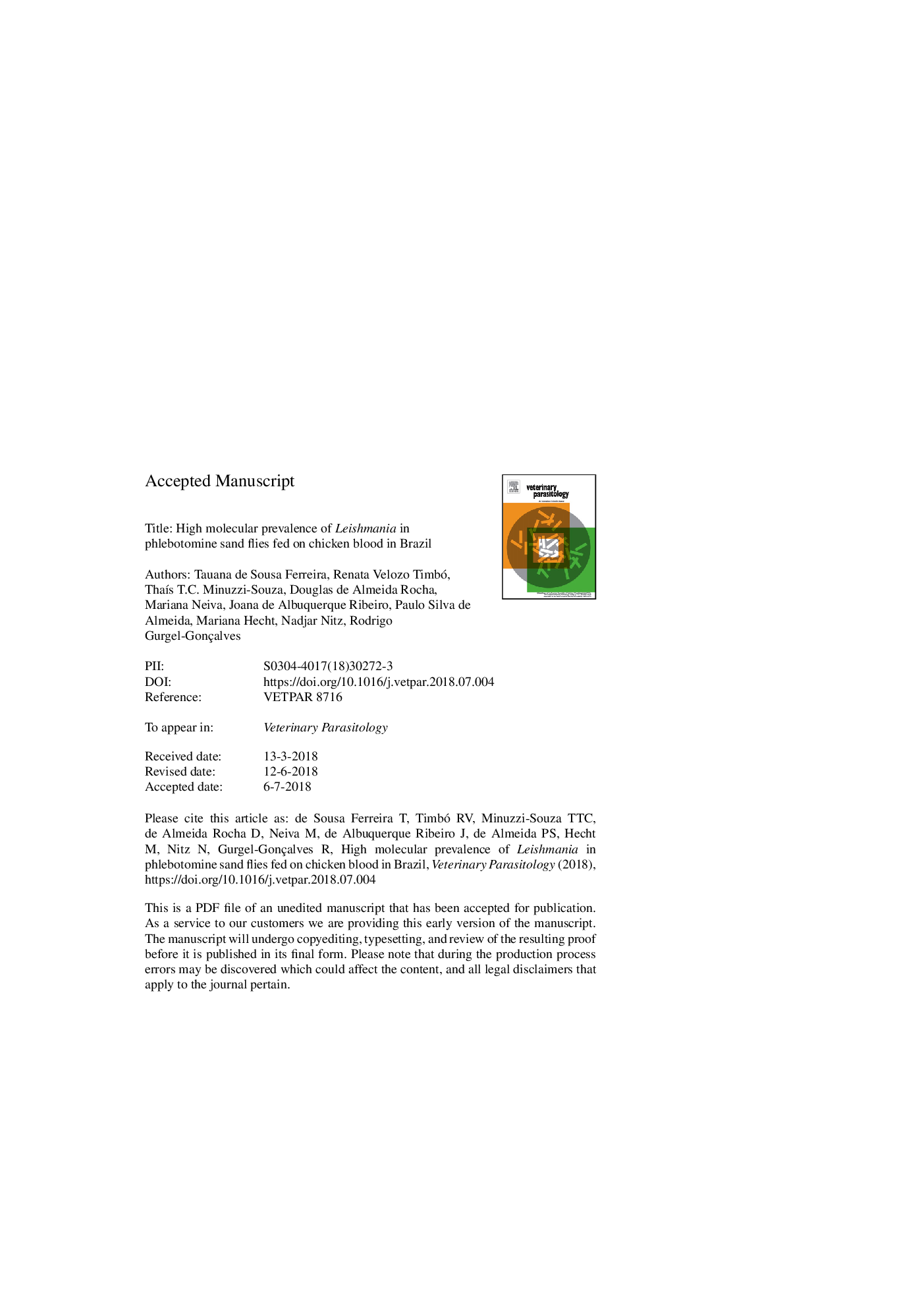| کد مقاله | کد نشریه | سال انتشار | مقاله انگلیسی | نسخه تمام متن |
|---|---|---|---|---|
| 8505891 | 1555617 | 2018 | 25 صفحه PDF | دانلود رایگان |
عنوان انگلیسی مقاله ISI
High molecular prevalence of Leishmania in phlebotomine sand flies fed on chicken blood in Brazil
ترجمه فارسی عنوان
شایع مولکولی بالا لیشمانیا در مگس شنبلیله فلبوتومین خوراک بر روی خون مرغ در برزیل
دانلود مقاله + سفارش ترجمه
دانلود مقاله ISI انگلیسی
رایگان برای ایرانیان
موضوعات مرتبط
علوم زیستی و بیوفناوری
علوم کشاورزی و بیولوژیک
علوم دامی و جانورشناسی
چکیده انگلیسی
Leishmaniases are endemic in Brazil, where Leishmania infantum has been detected in humans, dogs, cats, and phlebotomine vectors. Monitoring synanthropic vector populations is critical for leishmaniasis control-surveillance in such transmission-prone areas. Here, a suite of molecular approaches were used to assess Leishmania infection prevalence and to identify blood-meal sources in a large sample of sand flies collected in anthropic environments of a Leishmania-transmission area in Mato Grosso do Sul State (Rio Verde de Mato Grosso municipality), Central-West Brazil. We sampled sand flies monthly (January-June 2014 and 2016) in one peri-domestic site within each of six neighborhoods with recent records of human visceral and/or tegumentary leishmaniasis. kDNA-qPCR plus rDNA ITS-sequencing were used to detect and identify Leishmania in pooled female sand flies. Individual engorged females (nâ¯=â¯58) were used for blood-meal analyses through High-Resolution Melting (HRM) targeting the mtDNA cytb gene. Overall, 90.5% of 420 CDC trap-nights yielded vectors, for a total catch of 24,989 sand flies. We sub-sampled and identified 3088 sand flies of 12 species, including 2775 Lutzomyia longipalpis (the most abundant species at all sampling sites) and 297 Nyssomyia whitmani. Female sand flies (n = 1261) were grouped in 159 pools, of which 92 Lu. longipalpis (minimum infection rate [MIR] 8%) and 7 Ny. whitmani pools (MIR 7%) were Leishmania kDNA-positive. Most positive Lu. longipalpis were collected in the 2016 rainy season. Sequencing confirmed L. infantum in Lu. longipalpis samples. HRM analyses identified chicken DNA in 57 sand flies (98.3%), 37 of which were Leishmania DNA-positive (64.9%); human blood was found in just one (Leishmania-negative) female. Our data show ongoing risk of L. infantum transmission to humans in the study area, where Leishmania-infected sandfly vectors are common and heavily rely on chicken blood in the peri-domestic environment.
ناشر
Database: Elsevier - ScienceDirect (ساینس دایرکت)
Journal: Veterinary Parasitology - Volume 259, 15 August 2018, Pages 80-84
Journal: Veterinary Parasitology - Volume 259, 15 August 2018, Pages 80-84
نویسندگان
Tauana de Sousa Ferreira, Renata Velôzo Timbó, ThaÃs T.C. Minuzzi-Souza, Douglas de Almeida Rocha, Mariana Neiva, Joana de Albuquerque Ribeiro, Paulo Silva de Almeida, Mariana Hecht, Nadjar Nitz, Rodrigo Gurgel-Gonçalves,
